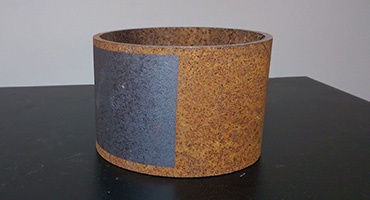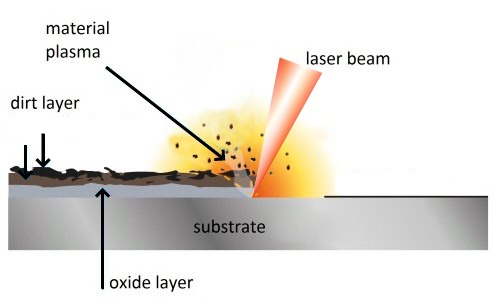
Laser cleaning is an environmentally friendly way to remove rust, paint, oxide or other contaminants from metal surfaces. Due to its efficiency, it is used in more and more applications. Laser cleaning requires a pulsating fiber laser (usually 50 watts or more).
Traditional industrial cleaning methods are often considered tedious (and for good reason). Rust removal can be both time consuming and labor intensive. Oxide removal can involve hazardous chemicals that are specific to each material being cleaned. In some cases, removing the paint with a sandblast can damage the metal beneath it.
Dealing with these problems usually comes at a price, but laser cleaning changes that: it is a cost-effective solution that reduces downtime and maintenance.
If you are skeptical about the claims that laser technology allows for itself, read on to find out the key facts about what a laser does to remove contamination and coatings.
-
Each material has an ablation threshold
Laser ablation (removal of material by evaporation) occurs when a layer or coating on the surface of a material is removed with a laser beam. This process is behind all laser cleaning equipment. For example, laser rust removal from steel surfaces. When the beam reaches the surface, the molecular bonds in the dust or rust layer are broken and expelled from the lower material. In less technical terms, it is conceivable that the coating evaporates from the surface of the material by means of a laser beam.

An easy way to imagine an ablation threshold is to compare it to throwing a ball over a fence. If you don't throw it high enough, it will never get to the other side. Even if you throw it over a thousand times, it still won't work. The same application applies to laser rust removal. The laser beam can be emitted a thousand times, but as long as the energy is below the ablation threshold of the material, nothing is removed from the material.
Now, each material has different properties and thus different molecular bonds. In other words, each material has its own ablation threshold. In order to successfully remove the coating from a material, it is necessary that the amount of energy given is above the ablation threshold of that material.
-
The material can be removed in a very selective way.
Let's continue with the previous analogy. Let's imagine that behind the first wall is the second higher wall and the ball is thrown over the energy to get over the first wall, but not the second. The ball would bounce off the other wall and stay between the two walls. Again, no matter how many times the ball is thrown, it would always have the same result. Would get over the first wall, but never over the second.
Because each material has an ablation threshold, laser cleaning can distinguish between two or more materials when trying to remove an unnecessary layer from an object. If the difference between the ablation thresholds of the two materials is large enough, it is possible to choose which material to remove (i.e., the one with the lower threshold) without leaving the other material intact.
For example, the ablation threshold for rust is lower than for common metals such as steel and aluminum. The same goes for paint and oil. Due to this high difference in values, the contamination and coatings are completely evaporated without the risk of damaging the lower material. There just isn't enough energy for that.
-
A fast and short pulse means fast removal
Laser ablation can be thought of as carving a stone with a hammer and chisel. It is possible to use a small hammer and make small blows to the chisel. Alternatively, a larger hammer can be used to generate more force, reducing the number of strokes required and increasing the removal rate. The same idea applies to laser cleaning, except that only one layer of material needs to be removed: contamination.
Fiber laser cleaning devices can remove layers in two different ways. Whether the laser beam is a continuous wave of light or pulses at a certain interval. Although the result is basically the same, the removal rate varies according to the method.

By putting the same energy into a short pulse for a given area, it is possible to increase the power. It would be like using a bigger hammer. The pulsating laser beam is much more efficient and provides a higher removal rate compared to a continuous laser beam. And although short pulses clean surfaces faster, it also ensures that the substrate does not overheat.
-
It is consumer and free
Since this method only uses a laser beam to evaporate the removable layer, there is no cost involved. It is the magic of lasers that only need to be connected to the network and is ready to go immediately.
In addition, lasers do not use chemicals or solvents. This makes laser cleaning a safer way to remove rust and coating contamination. Not only is there no chemical residue to deal with, but it is also safe for workers to work next to a laser cleaning machine that meets laser safety standards. Workers do not need personal protective equipment and do not have to deal with annoying chemicals.
Although, because the materials evaporate during laser cleaning, there should be a smoke removal system next to the laser to ensure that no oil, paint, or dust particles are released into the air.
-
Laser cleaning is an object of interest for various industrial applications
Removal of rubber residues from tire molds; giving new life to old pipes; pipe cleaning in nuclear power plants; and even larger projects, such as removing paint from rusty bridges and preparing weld material, are all projects that would benefit from industrial laser cleaning.
This contactless cleaning technique can be used in a myriad of industrial applications. The only limit is the ability to distinguish between the material to be removed and the material to be cleaned.
Currently the most common laser cleaning applications are:
- Pretreatment of welding to remove rust and other contaminants from welding areas.
- Post-treatment of welding to remove steel and aluminum oxides.
- Laser pre-treatment to maximize paint adhesion
- Laser removal of oxides from metal alloys
- Removal of the coating after the coating process to correct paint defects on the production lines
- Removing paint from products that would be trashed due to paint defects
Laser ablation is not only used for cleaning, it is also used for other industrial applications.
in conclusion
Laser cleaning solutions overcome a number of problems in rust removal and other industrial applications. By choosing a specific material to remove, fiber lasers offer a fast yet set-and-forget option for many industries.
The text has been translated: Laserax.com
